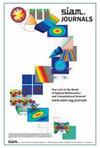Sampling-based Spotlight SAR Image Reconstruction from Phase History Data for Speckle Reduction and Uncertainty Quantification
IF 1.9
3区 工程技术
Q2 MATHEMATICS, INTERDISCIPLINARY APPLICATIONS
引用次数: 1
Abstract
. Spotlight mode airborne synthetic aperture radar (SAR) is a coherent imaging modality that is an 5 important tool in remote sensing. Existing methods for spotlight SAR image reconstruction from 6 phase history data typically produce a single image estimate which approximates the reflectivity 7 of an unknown ground scene, and therefore provide no quantification of the certainty with which 8 the estimate can be trusted. In addition, speckle affects all coherent imaging modalities causing a 9 degradation of image quality. Many point estimate image reconstruction methods incorrectly treat 10 speckle as additive noise resulting in an unnatural smoothing of the speckle that also reduces image 11 contrast. The purpose of this paper is to address the issues of speckle and uncertainty quantification 12 by introducing a sampling-based approach to SAR image reconstruction directly from phase history 13 data. In particular, a statistical model for speckle as well as a corresponding sparsity technique to 14 reduce it are directly incorporated into the model. Rather than a single point estimate, samples 15 of the resulting joint posterior density are efficiently obtained using a Gibbs sampler, which are in 16 turn used to derive estimates and other statistics which aid in uncertainty quantification. The latter 17 information is particularly important in SAR, where ground truth images even for synthetically-18 created examples are typically unknown. While similar methods have been deployed to process 19 formed images, this paper focuses on the integration of these techniques into image reconstruction 20 from phase history data. An example result using real-world data shows that, when compared with 21 existing methods, the sampling-based approach introduced provides parameter-free estimates with 22 improved contrast and significantly reduced speckle, as well as uncertainty quantification information. 23基于相位历史数据的基于采样的聚束SAR图像重建,用于散斑减少和不确定度量化
. 聚束模式机载合成孔径雷达(SAR)是一种相干成像方式,是遥感领域的重要工具。现有的基于6个相位历史数据的聚焦SAR图像重建方法通常只产生一个近似未知地面场景反射率的单一图像估计,因此无法量化该估计的可靠性。此外,散斑影响所有相干成像模式,导致图像质量下降。许多点估计图像重建方法错误地将斑点视为附加噪声,导致斑点的非自然平滑,也降低了图像的对比度。本文的目的是通过引入一种基于采样的方法直接从相位历史数据中重建SAR图像,来解决散斑和不确定性量化问题。特别地,在模型中直接引入了散斑的统计模型以及相应的稀疏化技术来降低散斑。不是单点估计,而是使用Gibbs采样器有效地获得所得关节后验密度的样本15,这些样本16反过来用于导出估计和其他有助于不确定性量化的统计数据。后一种信息在SAR中尤为重要,因为即使是合成的例子,地面真值图像通常也是未知的。虽然类似的方法已经被用于处理形成的图像,但本文的重点是将这些技术整合到相位历史数据的图像重建中。使用实际数据的示例结果表明,与现有的21种方法相比,所引入的基于采样的方法提供了无参数估计,提高了对比度,显著减少了散斑,并提供了不确定性量化信息。23
本文章由计算机程序翻译,如有差异,请以英文原文为准。
求助全文
约1分钟内获得全文
求助全文
来源期刊

Siam-Asa Journal on Uncertainty Quantification
Mathematics-Statistics and Probability
CiteScore
3.70
自引率
0.00%
发文量
51
期刊介绍:
SIAM/ASA Journal on Uncertainty Quantification (JUQ) publishes research articles presenting significant mathematical, statistical, algorithmic, and application advances in uncertainty quantification, defined as the interface of complex modeling of processes and data, especially characterizations of the uncertainties inherent in the use of such models. The journal also focuses on related fields such as sensitivity analysis, model validation, model calibration, data assimilation, and code verification. The journal also solicits papers describing new ideas that could lead to significant progress in methodology for uncertainty quantification as well as review articles on particular aspects. The journal is dedicated to nurturing synergistic interactions between the mathematical, statistical, computational, and applications communities involved in uncertainty quantification and related areas. JUQ is jointly offered by SIAM and the American Statistical Association.
 求助内容:
求助内容: 应助结果提醒方式:
应助结果提醒方式:


